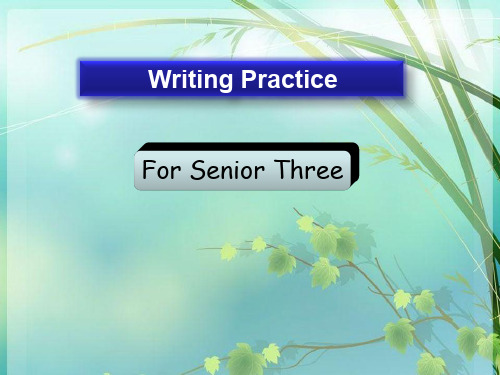《高级英语写作》说课课件
高级英语写作PPT课件

Introduction to Essay Development
❖ Traditionally,essay writing has been divided into the following patterns of development:
❖ Description ❖ Narration ❖ Exposition ❖ Argumentation
Important considerations in essay development
❖ Understand the nature abd length of an assignment ❖ your known subject
❖ Be able to appreciate and write essays with certain rhetorical devices.
❖ 4.Be able to think more systematically and logically.
Today’s task
❖ 1. Reflect on the TEM exam and look forward to the future . Write a reflection.
❖ Products include food and drink (especially brewing), instrument engineering, electrical and electronic engineering, clothing, furniture and printing.
1.Reflection of TEM 4
❖ What is your feeling now after the tedious preparation and the examinition?
高中英语写作公开课ppt课件

PPT内容要精炼简洁,避免冗长繁琐。
文字要简短明了,避免使用大段文 字。
字体大小要适中,避免过小或过大。
添加标题
添加标题
添加标题
添加标题
使用关键词或短语,突出重点信息。
字体颜色要与背景色形成对比,避 免看不清。
感谢您的耐心观看
汇报人:
针对不同文体进行写作技巧讲解
记叙文:注意叙事顺序,情节曲折,人物塑造 议论文:论点明确,论据充分,论证严密 说明文:抓住事物特征,条理清晰,语言准确 应用文:格式规范,语言得体,内容符合要求
分析经典英文写作范文,提炼写作技巧
逐句分析,提炼句式、词汇 和表达方式
总结范文写作技巧,引导学 生掌握写作要领
字体大小适中,颜色搭配合理
字体大小:根据幻灯片布局和观众距离调整,确保清晰易读 字体颜色:与背景色形成对比,突出重点内容,避免使用刺眼颜色 文字排版:遵循简洁明了原则,避免文字堆积和混乱布局 文字数量:精简文字内容,突出重点,避免过多文字干扰观众理解
图文并茂,增强视觉效果
文字与图片结合,增加视觉冲击力 图片选择要符合主题,清晰度高 图片与文字排版要简洁明了,易于理解 色彩搭配要合理,避免过于花哨或单调
课堂总结与作业布置
总结本节课所学内容及重点难点
回顾本节课所学的 单词和短语。
复习本节课所学的 语法和句型。
强调本节课的重点 和难点。
总结本节课所学的 写作技巧和方法。
布置课后作业及要求
作业内容:根据本节课所学内容,写一篇80-100词的英语作文。 作业要求:认真审题,结合本节课所学知识,注意语法和单词的拼写,书写工整。 上交时间:下节课上课前提交,逾期不候。 奖励机制:对完成出色的同学进行表扬和奖励。
2020年高级英语写作课件

Elements of Narrative Writing
CONFLICT
Plot Structure of Narrative Writing
• Beginning: – Enticing opening to capture readers’ interest. – Setting revealed. – Main characters introduced. – Conflict presented.
was really motivated by her desire to look up new information about her favorite rock band.
Types of Conflict: Examples
Person versus Person: Abby and her best friend Megan are working together on a group project. Abby did not do any work, leaving it all for Megan to do. When the girls get together to do the project, Megan finds out Abby did not do any work. She becomes angry, yells at Abby, and storms out of the room.
Plot Structure of Narrative Writing
高级写作-《高级英语写作I.doc

《高级英语写作》教学大纲一、课程名称:《高级英语写作》I,II,III.二、课程性质本课程是为英语专业蒙语授课学生开设的一门专业限制性选修课。
学生需在修完一,二,三年级的英语专业课和英语写作课后选修本课程。
三、教学目的本课程是英语专业蒙语授课高年级课程,旨在训练学生进一步提高实用写作能力,帮助学生提高实际语言应用能力,为学生在今后的学习和工作中所需的实用写作能力打下良好的基础。
训练内容主要包括议论文、记叙文、说明文,描写文等的写作,要求学生不仅掌握这些体裁的基本知识,而且要进行大量的有关体裁的习作练习。
本课程还要为学生提供有关撰写毕业论文的有关知识和有关练习。
同时使学生能够灵活运用英文的不同句式,掌握不同英语文体的特点,并能进行不同文体的写作,掌握能够用英语进行较为规范的学术写作的技巧。
四、课程教学原则及教学方法本课程的教学应与阅读密切相连,学生应阅读大量不同文体的范例,做到“以读促写”同时学生需要做大量写作练习,熟悉不同文体的写作特点,并要辅以教师以及学生之间的讲评。
教师可引导学生发现英文写作在句式特点,篇章布局,修辞方法上的特点,以使学生较好地掌握英文写作的技巧。
课堂教学应以学生为主体、教师为主导,注意培养学生的学习能力和研究能力。
在加强训练的同时,采用启发式、讨论式、研究式的教学方法,充分调动学生的积极性,激发学生的学习动机,最大限度地鼓励学生参与教学的全过程。
课堂教学要与学生的课外学习和实践相结合,开展练习读与写相结合的活动。
在写作实践上要把开发和培养学生搜集材料,表达独特而又言之有据的观点的能力作为写作教学的重要教学原则之一。
五、课程时间及学分本课程开设时间为3个学期(第12,14,15学期),每周2学时,17周,共9学分(其中实习,写毕业论文各占4星期) 。
六、课程教学内容及学时分配本课程的教学内容分为两部分,即英文写作理论与英文写作实践。
英文写作理论教学与写作实践并行。
具体包括:英文写作的过程,步骤;文章的组织;不同文体的写作及英文修辞。
高中英语作文写作教学公开课ppt课件

句子1 翻译
句1:学生会将要举办一次英语演讲比赛。目的: 增长环保知识和提高英语口语。主题:“保护环 境, 节约能源”。
The Students’ Union is going to organize an English-speaking contest to increase our knowledge about the environment and iTmhperothveem适更oue当加riss调顺:p“o整畅PkreonteEcnt goluisrhe.nvironment and save our energy”.
英语作文写作 What makes
a good essay?
1
基础写作中存在的主要问题及分析
1. 话题词汇、短语错误 积累少
2. 词汇、短语、句型贫乏
3. 句子语法错误
语法不扎实
4. 连贯性差
篇章意识不足
2
考场作文TIPS
1.取悦评卷人: 有清晰的整体脉络, 有自然的段间衔接. 经典的用词用句, 有整齐美观的书写. 2.经典的用句: 感叹句,倒装、强调、虚拟、省略句、定 语从句,名词性从句,名人名言。
学生会 _T_h_e_S_t_u_d_e_n_ts’ Union
参加 __ta_k_e_p_a_r_t_in_/_p_a_r_ti_cipate in
保护 _p_r_o_te_c_t_(v_t_) protection(n)
环境 _e_n_v_ir_o_n_m__en_t__(n_)_e_n_v_ir_o_n_m_e_n_t_a_l _(_a_dj)
中文没有主语 时:要补充主 语再翻译。
20
句子4、5 翻译
句4: 奖项:3个一等奖, 6个二等奖和12个三等奖。
《高级英语写作》说课课件

Unit 1 Reflecting on Your Writingwrite. What and why you Purpose of writing Types of English writing Prewriting, writing, Stages in the writing process rewriting Features of good writing How well are you doing? A study plan
Unit 8 Writing a report
Setting the framework Writing introductions Interpreting results Coming to a conclusion Compiling a bibliography A Practical Project Design
Unit 7 Making arguments
Your position and being arguable Constructing arguments—Argumentative strategies(1) Constructing arguments—Argumentative strategies(2) an argumentative Evaluating arguments Public debate and sample analysis
Describing places Taking in the view Describing people Habits and customs Describing objects Describing processes
A descriptive
Unit 5 Telling what happened
高中英语:写作公开课说课稿及课件-复杂句式(文本)

高中英语:写作公开课说课稿及课件-复杂句式(文本)How to use common sentence structuresHello, everyone. I’m glad to be here to talk about my teaching ideas on How to use common sentence structures in the students’ writings.First, I’ll say about the aim of this lesson: It’s to improve the students’ writing by using common sentence structures.Then I’ll analyze the students: They have known some writing skills. But they don’t really master them. Some of them write English compositions just according to the Chinese meaning word by word. So they can’t get high scores.To learn it well, I’ll use the following teaching methods: group work method and task-based learning.The teaching aid I use in this class is multi-media .There are 7steps in my teaching.Step 1: Lead in with a Brain storm(3’)Step 2: compare some sentences and decide which are better. (3)Step 3: list the sentence structures we usually use? (5’)Step 4: Make sentences using different sentence structures. (10’)Step5: Fill in the blanks in 2 model passages (5’)(complete 2 passages)Step 6: Enjoy and analyze two good compositions from the students in our class. (5’)Step 7: writing(14’)Next, I’ll explain them in details.Step1: Ask the students to think about a question ( brain storm)What is a good composition like in your mind?Of course, the students may have different answers, such as, good handwriting, few spelling mistakes, few grammatical mistakes, using proper connectives etc. After the brainstorm, I’ll show the summary of a good composition on the screen. There’re five features of a good composition in the entrance examinations.行文逻辑,条理性好巧用过渡词,逻辑性强巧用高级词汇及句式,文章品味高妙用变通式表达,文章错落有致书写规范,整体效果好A good composition has many factors. I list some of them: advanced vocabulary, complex sentences, commonlyused sentence structures,proper connectives or trasitional words and a well-organized passage and so on.Then I will remind the students today we’ll focus on the third point. In this step, using a question leads to the topic of this class , and make the students learn the five features of a good composition, and realize using common sentence structures is a good way to write a good composition.Step 2: compare 5 groups of sentences . In each group , there are two sentences.To my surprise, the girl knows so many things.For exampleWhat surprises me is that the girl knows so many things.Then I’Of course ,the students may point out the second sentence is better because it uses what clause and noun clause.In this step I’ll ask the students to learn some useful sentence structures ,such as adverbial clause, noun clause ,with structure, subjunctive mood etc. after this step the students will realize the sentences with some sentences structures are really more excellent.Step 3: Summarize what kinds of sentence structures can we use?(discuss)Ask the students to write down and remember the followings.1、定从,状从,宾从,主从,同位语从句2、使用变化多样的句式,疑问句,祈使句,倒装句,省略句3、使用非谓语动词,强调句型及其他固定句型In this step, the students can get some theories about sentence structures, and they can use the theories to direct them to improve their compositions.Step 4: Make 10 sentences using different sentence structuresFoe example:只有用这种方法,你才能取得进步。
BEC高级写作课件

CAMBRIDGEBUSINESS ENGLISH CERTIFICATEHIGHERBEC高级写作讲义内部资料,仅供参考目录一.BEC考试概述二.BEC高级写作概述三.Part One写作(概述与方式) 四.Part Two写作(概述)五.Part Two (Report写作方式) 六.Part Two (Proposal写作方式) 七.Part Two (Letter 写作方式) 八.总结教科书:《剑桥BEC真题辑》第2、3辑练习资料:《剑桥BEC真题辑》第4辑一.BEC考试概述剑桥商务英语(Cambridge Business English Certificate):简称为BEC考试,是英国剑桥大学考试委员会专门为非英语母语国家的人员进行国际商务活动需要而设计的。
该证书由于其颁发机构的权威性,在欧洲大多数国家的商业企业部门获得认可,作为确认证书持有者英语能力证明的首选证书。
也是在所有举办该项考试的国家和地区求职的“通行证”。
在一些国家,许多大学要求获得BEC3(第三级)证书者才能获得工商管理硕士(MBA)学位或参加学位课程学习。
BEC考试特点:1.BEC考试报名不受年龄、性别、职业、地区、学历等限制,任何人(包括学生、待业人员等)均可持本人身份证到当地考点报名。
2.BEC考试测试考生在听、说、读、写四个方面的语言交际能力,着重考察学生的应用能力与接受能力,并对考生的能力概况做出较全面、客观的评价。
3.BEC考试分为三级,BEC1为初级语言水平考试,难度相当于我国大学英语四级,就剑桥英语考试系列来说,它介于入门英语考试(Key English Test)和初级英语考试(Preliminary English Test)之间;BEC2介于我国大学英语四、六级之间,相当于剑桥第一证书英语考试(First Certificate in English);BEC3介于我国大学英语六级和英语专业八级之间,相当于剑桥熟练英语证书考试(Certificate of Proficiency in English)。
高级英语写作PPT课件

列举常用的表达方法有:first, second, in the first place, first of all, to begin with, in the second place, next, also, besides, furthermore, moreover, in addition, what is more, beyond that, for one thing, for another, finally.
(启) In general/Generally speaking/On the whole, studying too hard may be harmful to audients. (启)
Lately/Currently/At present/Now/Recently, many teachers expect their pupils to do more work than they can handle. (承) Moreover /Also/Furthermore/Meanwhile/What is more, parents do not realize that pressing their children to study harder than called for can injure their health.(承)
As a result / Consequently / Thus / Therefore /Hence/In brief/In conclusion, some students may very possibly fail in school because of this pressure to study in excess of w过渡语在英语写作中极为重要,可以说, 无过渡语就不构成文章。
高级英语写作.ppt

4 . Why do you choose to study at … University ?
5 . How will you pay all your expenses during your stay in the States ? / Who’s responsible for your expenses during during your stay in the States ? Who’s your sponsor ?
Wild Turkey Lore
Wild Turkeys are masters of camouflage and evasion. A large flock of birds will lie quietly within yards of a man passing through the forest, and never be seen.
Importer: The East Asian Co. (Singapore)
Expiry date: 12 months
Visa Application Interviews
1 . What’s your purpose in applying for a visa ?
2 . Why do you want to go the U . S ? / Why do you choose to study in the United States ?
The Wild Turkey is truly a native bird, unique to America. And it is the unique symbol of the finest native whiskey in America Wild Turkey.
高中英语写作示范课 PPT课件 图文

In a word…
pre-writing
relieve our burdens
while-writing
post-writing
Brainstorming
raise confidence
cut down the distance
Advantages of smiling
escape the pressure
pre-writing
while-writing
post-writing
Writing
• 某英语报社拟成立“微笑俱乐部”,现向全 球
征募会员。要求申请者提交一篇题为“I want to Smile”的英语短文。请你以申请者的身份,根据 以下思路图的提示用英语写一篇短文。 注意: 根据思路图适当展开,以使行文连贯; 词数:120左右
It's full of worth and goodness, too, with
manly kindness blend(融合);
It’s worth a million dollars, and it doesn’t cost
a cent.
There is no room for sadness when we see a
clear up misunderstanding
kick sorrow away
pre-writing
while-writing
post-writing
Note-writing
•Ihewlpanmtetooutsmofilmeaanty dmifyficpualtrieesnts or •fcroiemnfdosrt omre…when I’m upset •Tshtaendrebaysmonesa:ndFcirasret,a…boutSmeecond,…
高中英语写作说课课件_

stand for make the most of lie off/ to / in / on
be made up of of great value
3. 英国的地理位置与组成﹑气候特征﹑历史 文化以及交际语言。(step3 chart)
六、教学评价
Unit5 The British Isles
Discuss in groups to find the main idea of each paragraph:
Book 4 Module 2
Speaking & Writing
教学过程
Unit5 The British Isles
Step 8: Summary .(2 mins.)
1. 文章结构;(topic sentences)
五、教学过程
Module 2 Traffic Jam
Step 4: Writing
① Ss read the passage individually, answer the questions and then check in pairs. ② Call back the answers from the whole class, and then emphasize the structure of the passage.
what’s worse / worse still / even worse
what’s more / besides / in addition / moreover
Something must be done to solve the problems. There is a simple solution to these problems
高级英语写作免费课件

•If a character is not described well, the story will not be believable.
all the characters. – Example: “She called him a liar, though she knew
he was telling the truth.”
5 W+H Questions Method
• Answering the 5 W and H questions provides the basic info needed to begin a story.
Narrative Writing
What is Narrative Writing?
• A narrative is a story containing specific elements that work together to create interest for not only the author but also the reader.
• Every student has his/her own style and technique. Although we have the same topic, everyone will write differently.
Elements of Narrative Writing
CONFLICT
Elements of Narrative Writing
SETTING
高中英语写作课说课(获奖) PPT 课件

• Ending
•
_________________________________
•
_________________________________
•
……
Homework
Work in groups of two, each designing
a writing task -a letter of inquiry and asking the other to finish it.
回答问题,故用词要fea礼tu貌re、s 恳of切th,e 且助无都Pofu论应Drp对该eos方事siDge是先insc否表us愿示siSn意感liaiengmctq或谢ttiieluva能。rierrsi够yttoihefb提isny供karts
Work in groups of four
Knowledge:
Structure/lexi cal chunks
Ability: 1)Writing skill/ 2) Solve problems with English
基本思路
11 ATded YaocurhTeixnt g materials 2 Students
3 Teaching methods 4 Procedures
gratitude
Part 3
wish for an early reply
The ending
Group work
1. Work in groups of four. One of you acts as a recorder.
2. Find out the lexical chunks(词 块)in the three letters .
高考英语作文写作公开课PPT课件

Language use
02
03
04
01
Writing skills
Prompt Review
Analyze the specific instructions and requirements provided by the question
Title Review
Identify the main topic or concept of the composition
Reading is an effective way to improve English writing ability.
Summary
Candidates should read more English articles, especially classic and historical papers, to cultivate language sense and reading comprehension ability. At the same time, pay attention to analyzing the structure, sentence structure, and vocabulary of the article, and learn excellent expression methods.
01
Introduction Structure
Start with a clear introduction that hooks the reader's interest
02
Body Organization
Organize ideas into a logical flow that supports the main argument
高级英语写作精品PPT课件

EX. Compare the following pairs of sentences
and discuss their style.
Men were reluctant to retire, because they anticipated that they would be deprived of money rather than work.
A Reluctance among men to retire was associated with anticipated deprivations, mainly of money rather than of attachment to work.
EX. Compare the following pairs of sentences
informal and conversational for academic writing.
Avoid run-on sentences. Run-on sentences are common in speech and other informal interactions because we just keep adding something we wanted to say. In writing, however, these run-ons become distracting and
Avoid using the second person pronouns such
as “you”, etc. these pronouns make your
writing sound like you are address readers orally.
Eliminate contractions such as isn’t, don’t, you’re, etc. which are considered too
大学高级英语写作 PPT

• Practice make perfect.
What’ s the purpose of writing? What’ s your feelings about writing (in English and Chinese)?
Positive view Negative view What’ s the types of writing ?
课程终结考核:形式为闭卷,笔答。满分为100分,由中央电大统一
命题,在同一时间全国统考。考试时间为90分钟。
Reading and Summary (35 points) Writing a letter (25 points) Writing (40 points)
• 命题依据 本课程终结性考试的命题依据是中央广播电视大 学本科开放教育英语专业教学计划、课程教学大纲以及 “高级英语自学系列教程”中的《高级英语写作》教材。
texts; • recognise the features of a well-written text; • assess your own writing performance;
• Set goals and methods of practice.
• Reading maketh a full man; conference a ready man; and writing an exact man.
Step 2 Devteolpoipc stheentteonpcice s1e(nstuepnpceosrtianngdpsouinptp1o)rt it with
Body
topic sentence 2 (supporting point 2)
spetocpifiicc seevnidteennccees3. (supporting point 3)
高中英语写作课说课(获奖)优选教学课件

人的一生总有很多回忆是挥之不去的,青春的记忆就像五彩斑斓的花束,散发着淡雅的馨香,我曾小心翼翼地将它们修剪成干枝夹在《繁星诗集》里陈放多年。是昨夜的雷雨扰我无法入梦,才让我不经意间看到了这些文字,读着读着这些文字变得不安生起来,它们硬生生地将我拉回到了中考那年。 那年的夏天,我的中考成绩下来了,心里却开始犯了难。 高中和中专不知该如何选择。我很想去读高中,因为它是通往大学唯一的桥,那是我最向往的地方。可是,高中和大学一共要读六年,我的家境在当时是无法支付这高额的学费的。考虑再三还是决定去读中专。即便是选择中专,也是父亲咬紧牙答应下来的,我深知父亲的难处。 九月份开学的那一天,十七岁的我揣着家里仅有的一千多块钱,一个人拖着沉重的行李坐上了客车,奔向了那个陌生的城市。车终于到站了,我把大包小卷的行李刚拿下来,几辆出租的三轮车,就蜂拥而来,一个晒得很黑的中年男人问我:小姑娘去哪啊?我怯怯地回答:你卫校去吗?他忙应道:“去啊!你是报到的新生吧?”面对陌生人的问话,我显得有些拘谨,他看看我,笑了笑也没再多问,他把我送到校门口,取下所有行李后就离开了。 这座卫校没有想象中的高大上,但整洁干净,一切井然有序,当看见醒目的“欢迎新生”的条幅粘贴在大门口时,心里还是萌生出一丝温暖。大厅里的人不多,我的行李散放在地上,一个人怯生生地伫立在拐角,观察着大门外来来往往的人。他们和我一样也是新生,不同的是他们都有父母相伴,或者是姐妹相拥,我欣羡的目光在他们身上游移。他们的欢声笑语,同时感染了我的嘴角,不由得也跟着扬了扬。他们一前一后拥进门,整个大堂顿时热闹了起来。大堂里早已设好了几个缴费的窗口,看着他们握着大把的钱,一项一项地排队交钱领着收据,我好生羡慕啊!此时,我的心里开始打起鼓来,明知道钱不够,还逞强跟父母说没事,这下好了,这一千块钱该交哪一项呢?我该怎么办?我又不敢上前去打听,拽着背包带的手都渗出汗来。大厅的人越来越多,喧闹嘈杂的声音使我倍感孤独,
- 1、下载文档前请自行甄别文档内容的完整性,平台不提供额外的编辑、内容补充、找答案等附加服务。
- 2、"仅部分预览"的文档,不可在线预览部分如存在完整性等问题,可反馈申请退款(可完整预览的文档不适用该条件!)。
- 3、如文档侵犯您的权益,请联系客服反馈,我们会尽快为您处理(人工客服工作时间:9:00-18:30)。
教学安排): Ⅲ、Teaching arrangement (教学安排 教学安排
In class: Unit 1 in the first morning. Unit 2 & 3 in an afternoon. Unit 4,Unit 5 & Unit 6 in one morning. Unit 7 & Unit 8 in one afternoon. After class: Request the learners to arrange for suitable time to finish the added reading and listening tasks themselves.
How to Mark?
/ This word is not necessary ^ Add (a) word(s) A Agreement between subject and verb C Capitalisation P Punctuation Sp Spelling V Wrong verb form T Tense Ww Wrong word Wo Word order
Unit 8
Presenting Your Ideas (expositary)
Unit 7
Unit 2 Getting Ideas
Unit 6
Unit 1
Unit 5 Unit 4
Sorted Out (summarize)
Unit 3
Telling What Happened (narrative)
Describing places Taking in the view Describing people Habits and customs Describing objects Describing processes
A descriptive
Unit 5 Telling what happened
Unit 2 Correspondence
Letter format Personal and informal letters Formal letters Addressing an envelope Principles of good letter writing
1 Componets of a letter
Unit 1 Reflecting on Your Writingwrite. What and why you Purpose of writing Types of English writing Prewriting, writing, Stages in the writing process rewriting Features of good writing How well are you doing? A study plan
Unit 8 Writing a report
Setting the framework Writing introductions Interpreting results Coming to a conclusion Compiling a bibliography A Practical Project Design
Unit 7 Making arguments
Your position and being arguable Constructing arguments—Argumentative strategies(1) Constructing arguments—Argumentative strategies(2) an argumentative Evaluating arguments Public debate and sample analysis
Thank you and good-bye!
E A B C D
A—sender’s name B—sender’s address C—recipient’s name D—recipient’s adrress E—a stamp
Unit 3 Getting ideas sorted out
Coherence in a paragraph Note-taking 1. five stages Taking notes from a lecture 2. five Do’s and don’ts Principles in writing a summary
Time and the order of events Coherence Narrating incidents and events Eyewitness A narrative Analysing
Unit 6 Presenting your ideas
Classification: Breaking subjects into parts Definition: Clarifying your ideas Exemplification: Demonstrating your ideas Comparison and contrast: Using familiar things to explain the unfamiliar Cause and effect: One thing leading to another An expositary
(ⅱ)Teaching material construction(教材结构 : ⅱ 教材结构): 教材结构
Writing a Report Making Arguments (Practical Project Design) (argumentative) Reflecting on Your Correspondence Writing (composition) (letter writing)
Describing What You See (descriptive)
Ⅱ、Teaching contents and important, difficult points(教学内容及重、难点 教学内容及重、 教学内容及重 难点):
(Tips:The important & difficult points are in red)
c e h g b
c
d f i
How to write a CV
1.Personal information cation 3.Experience 4.Special interests 5.Publication 6.Other information 7.References
Addressing an envelope
a.body b.salutation c.return address plimentary close e.date line f.signture g.inside address h.reference line i.printed name of sender
2 Position of componets
English for Studying is an important course in English Language Communication Module for self-study learners, which belongs to Help Yourself to Advanced English. It is thematically structured on English linguistics, cultrue and social situation. It is five-skill (listening, speaking, reading, writing, translating) integrated on activity /task basis. Kinds of studying-tasks are adopted for self-study learners to achieve abilities of communicating in real English.
Develop three capabilities: write good paragraphs in general take notes write a summary
Topic sentence: 1.general statement 2.specific statement
Unit 4 Describing what you see
Welcome To Ouglish for Studying
高级英语写作
南雄市委党校 辉 董书
教材分析): Ⅰ、Teaching material analysis (教材分析 教材分析
教材地位): (ⅰ)Teaching material position (教材地位 : 教材地位
